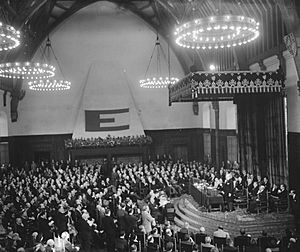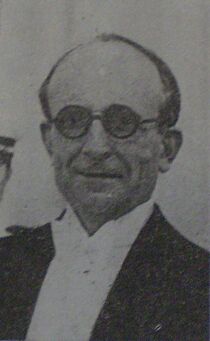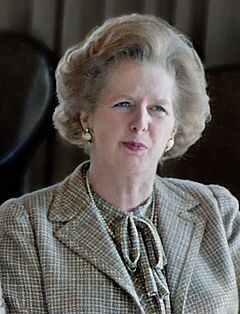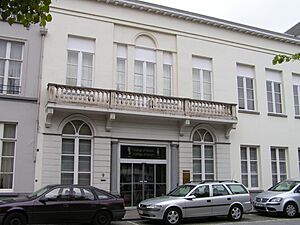College of Europe facts for kids
|
Collège d’Europe
Europacollege Kolegium Europy |
|
 |
|
| Type | Private postgraduate institute Établissement d'utilité publique |
|---|---|
| Established | 1949 |
| Chairman | Herman Van Rompuy |
| Rector | Federica Mogherini |
| Postgraduates | Annually ca. 500 students from over 50 countries |
| Location | |
| Working languages | English and French |
The College of Europe (French: Collège d'Europe; Dutch: Europacollege; Polish: Kolegium Europy) is a special school for students who have already finished their first university degree. Here, they learn all about Europe. It has three main locations: Bruges in Belgium, Warsaw in Poland, and Tirana in Albania.
The College in Bruges started in 1949. Important European leaders like Winston Churchill and Paul-Henri Spaak helped create it. Their goal was to teach young people to work together and understand each other across Europe. They also wanted to train future leaders for Europe.
After the end of the Cold War, a new campus opened in Natolin, Poland, in 1992. The Polish government gave the land for this campus. A third campus in Tirana, Albania, welcomed its first students in 2024.
The College of Europe is closely connected to the history of the European Union. Many of its graduates become important people in the EU. For example, Federica Mogherini, a former top EU official, became the Rector (head) of the College in September 2020. Herman Van Rompuy, a former President of the European Council, is the chairman of its board.
The Financial Times newspaper has called the College "an institution geared to producing crop after crop of graduates with a lifelong enthusiasm for EU integration." This means it helps students become very passionate about European cooperation. The BBC even called it "the EU's very own Oxbridge", comparing it to famous universities like Oxford and Cambridge.
Contents
History of the College
How the College of Europe Started
The College of Europe was the first school in the world to offer special studies and training in European affairs after a student's first university degree. It was founded in 1949 by important European figures. These included Salvador de Madariaga, Winston Churchill, Paul-Henri Spaak, and Alcide De Gasperi. They started the College after the Congress of Europe in 1948.
At the Congress, Salvador de Madariaga, a Spanish statesman, strongly suggested creating a College of Europe. He believed that students from different European countries studying together could help heal the damage from World War II.
A group of people from Bruges, led by Reverend Karel Verleye, helped bring the College to their city. Professor Hendrik Brugmans, a key thinker in the European Movement, became its first Rector from 1950 to 1972. The first group of students started in 1949. They studied how to teach history and develop a European spirit in universities.
Margaret Thatcher's Speech
In 1988, British Prime Minister Margaret Thatcher gave a famous speech at the College of Europe. This speech is known as the Bruges speech. In it, Thatcher shared her ideas for Europe. She believed the European Community should mainly be about economic cooperation. She did not want a closer political union or a "European superstate." This speech is seen as a key moment for the Eurosceptic movement, which eventually led to Brexit.
After the Cold War
After communism ended and changes happened in Central and Eastern Europe, the College opened a new campus. This was in Natolin (Warsaw, Poland) in 1992. The European Commission and the Polish government supported this new campus.
Former President of the European Commission, Jacques Delors, said this new College campus was a symbol of Europe coming together again. It also represented hope for more understanding and friendship. Opening this second campus in Eastern Europe helped train young students from those countries. This was important as more countries joined the EU.
Since then, the College works as "one College – two campuses." The special spirit of cooperation and learning is now known as the "spirit of the College."
In 2012, the College of Europe became a supporting member of the European Movement International. This organization works to promote European cooperation.
College Campuses
Bruges Campus
The Bruges campus has been in the center of Bruges, Belgium, since 1949. Bruges is in the Flemish Region, where people speak Dutch. However, the College uses English and French as its main languages.
The College has several student residences in Bruges. These are not far from the Dijver, which is the main building for administration and classes. Each residence is small, with no more than 60 students. This helps create a friendly, international environment in each one.
Dijver Building
The Paul Henri Spaak Building, often called Dijver, is the main administrative building in Bruges. It has the College's reception, offices, classrooms, and the library. It is located by the Dijver Canal. The building has a classic white front and a garden in the back. Students often use the garden during breaks because it's close to the library.
The library building was built in 1965. Princess Beatrix of the Netherlands (who later became Queen) helped lay its first stone. The library was updated and made bigger in 1992. Most of its books and resources are about European studies, law, economics, and politics. Only College students and staff can use the library.
Verversdijk Building
As more students joined the College, the 17th-century Verversdijk building was renovated. This added more classrooms and offices. The project was completed in 2007. Students use these premises for classes and other activities. After graduation, a special party is held in its garden.
The Verversdijk area was historically where dyers worked with wool. During the 17th century, it housed a monastery and schooling houses. The main monastery wing, built in 1701, is a beautiful example of the rococo style. Its attic, which is 45 meters long, is now a study room.
Since 2008, the College has displayed the 'Extraordinary Groeninghe Art Collection' in Verversdijk's hallways. This collection features modern art from international artists. In 2014, the "China Library" was opened here. It has ten thousand books about China and often hosts events about Chinese culture and its relationship with Europe.
Garenmarkt Building
The Hotel Portinari at Garenmarkt 15 was once home to Tommaso Portinari, a famous merchant in the 15th century. Today, it has apartments for professors and rooms for forty students. It also has beautiful old-style rooms and a modern dining hall for students. A room dedicated to Winston Churchill was opened here in 2017. The main student canteen is also located at Garenmarkt.
Biskajer Residence
The Biskajer residence is in a 19th-century building. It is located in Biskajersplein, a small square named after the Spanish region of Biscay. This area was where ships from Biscay unloaded goods long ago. The residence houses 53 students each year.
Gouden Hand Residence
The Gouden Hand residence is in a 17th-century building in the Bruges style. It was renovated in 2005–2006. Its name means "Golden Hand" in Dutch, from an old legend about the nearby canal. The student bar is in the cellar of this building. The Gouden Hand building has also been used as a setting for many films.
Natolin Campus (Warsaw, Poland)
The Natolin campus in Warsaw, Poland, opened in 1992. This was in response to the big changes in Eastern Europe after 1989. It also helped prepare Poland for joining the EU.
The Natolin Campus is in a historic palace. This palace is part of a large 120-hectare park and nature reserve. It used to be a royal hunting palace. The Natolin European Centre Foundation helps take care of the complex. They have restored the old Potocki palace and made it ready for the College.
Old buildings like the manor house and stables were updated for modern use. New buildings were also constructed to match the style of the palace and park. In 2022, the Natolin campus hosted one of the European citizens’ panels. These panels were part of the EU's Conference on the Future of Europe.
Tirana Campus (Albania)
In 2023, the College announced a new campus in Tirana, the capital of Albania. The Tirana campus welcomed its first students in the 2024–2025 school year. There were 32 students from 21 countries, mostly from the Western Balkans and the European Union. The College expects more students to join in the future.
Student Life at the College
How to Apply
Students can apply through special national selection committees in their home countries. If there isn't a committee, they can apply directly to the College. As of 2014, there were 28 such committees. About 70% of students receive scholarships from governments or other organizations. This helps them pay for their studies.
What Students Learn
The College of Europe is a bilingual school. This means students must be good at both English and French. It offers special one-year master's programs. These programs cover different areas related to European studies.
At the Bruges campus, students can choose from four master's programs:
- European Political and Governance Studies
- European Law
- European Economic Studies
- EU International Relations and Diplomacy Studies
The Natolin campus offers one program: European Interdisciplinary Studies. The Tirana campus offers a program in European Transformation and Integration.
The College also works with the Fletcher School of Law and Diplomacy at Tufts University. Together, they offer a joint Master in Transatlantic Affairs. Students in this program spend one year at each school.
College Traditions
The College of Europe has many special traditions. One tradition is naming each academic year after a famous European figure. This figure is called the "patron" of the year. Also, a well-known European politician traditionally opens each academic year.
Each year, College students are made honorary citizens of Bruges before they leave. The College also has "national days" or "weeks." During these events, students share their country's culture, food, and traditions. Another old tradition is a visit to Flanders Fields at the start of the year. Students lay flowers at the Menin Gate war memorial in Ypres.
Academic Years and Patrons
Academic years at the College are called promotions. Each promotion is named after an important European person, who is called the patron.
A famous politician, called the Orateur, leads the opening ceremony each year. Many important figures have been Orateurs, including Angela Merkel, Jean-Claude Juncker, and Margaret Thatcher. Being invited as the College's Orateur is a great honor.
| Year | Name of promotion (Patron) | Students | Speaker at opening ceremony (Orateur) |
|---|---|---|---|
| 2025-2026 | Victoria Amelina | ca. 500 | tbc (Bruges, Tirana) and tbc (Natolin) |
| 2024-2025 | Jacques Delors | 496 | Ursula von der Leyen (Bruges, Tirana) and Luc Frieden (Natolin) |
| 2023-2024 | Madeleine Albright | 462 | Petr Pavel (Bruges) |
| 2022-2023 | David Sassoli | ca. 470 | Roberta Metsola (Bruges) and Stevo Pendarovski (Natolin) |
| 2021-2022 | Éliane Vogel-Polsky | 472 | Alexander De Croo (Bruges) and Olha Stefanishyna (Natolin) |
| 2020-2021 | Mário Soares | 477 | Marcelo Rebelo de Sousa (Bruges) and Sviatlana Tsikhanouskaya (Natolin) |
| 2019-2020 | Hannah Arendt | 471 | Donald Tusk (Bruges) |
| 2018–2019 | Manuel Marín | 461 | Antonio Tajani (Bruges) & Tibor Navracsics (Natolin) |
| 2017-2018 | Simone Veil | 462 | António Costa (Bruges) & Andrzej Duda (Natolin) |
| 2016–2017 | John Maynard Keynes | 467 | Jean-Claude Juncker (Bruges) & Ivanna Klympush-Tsintsadze (Natolin) |
| 2015–2016 | Frédéric Chopin | 479 | Alexander Stubb (Bruges) & Johannes Hahn (Natolin) |
| 2014–2015 | Falcone & Borsellino | 437 | Mariano Rajoy (Bruges) & Petro Poroshenko (Natolin, cancelled) |
| 2013–2014 | Voltaire | 445 | Íñigo Méndez de Vigo (Bruges) & Bronisław Komorowski (Natolin) |
| 2012–2013 | Václav Havel | 444 | Helle Thorning-Schmidt (Bruges) & Vladimir Filat (Natolin) |
| 2011–2012 | Marie Sklodowska-Curie | 448 | Giorgio Napolitano (Bruges) & José Manuel Barroso (Natolin) |
| 2010–2011 | Albert Einstein | 435 | Angela Merkel (Bruges) & Štefan Füle (Natolin) |
| 2009–2010 | Charles Darwin | 402 | Jerzy Buzek (Bruges) & Toomas Hendrik Ilves (Natolin) |
| 2008–2009 | Marcus Aurelius | 381 | Yves Leterme (Bruges) & Hans-Gert Pöttering (Natolin) |
| 2007–2008 | Anna Politkovskaya & Hrant Dink | 415 | David Miliband (Bruges) & Carl Bildt (Natolin) |
| 2006–2007 | Nicolaus Copernicus | 413 | Jean-Claude Juncker (Bruges) & Alaksandar Milinkievič (Natolin) |
| 2005–2006 | Ludwig van Beethoven | 384 | Javier Solana (Bruges) & Viktor Yushchenko (Natolin) |
| 2004–2005 | Montesquieu | 404 | José Manuel Barroso (Bruges) & Josep Borrell Fontelles (Natolin) |
| 2003–2004 | John Locke | 391 | Joschka Fischer (Bruges) & Danuta Hübner (Natolin) |
| 2002–2003 | Bertha von Suttner | 370 | Valéry Giscard d'Estaing (Bruges) & Erhard Busek (Natolin) |
| 2001–2002 | Simon Stevin | 365 | Aleksander Kwasniewski (Bruges) & Guy Verhofstadt (Natolin) |
| 2000–2001 | Aristotle | 375 | George Papandreou (Bruges) & Jan Kulakowski (Natolin) |
| 1999–2000 | Wilhelm & Alexander von Humboldt | 374 | Jacques Delors (Bruges) & Jean-Luc Dehaene (Natolin) |
| 1998–1999 | Leonardo da Vinci | 337 | Jean-Luc Dehaene (Bruges) & Prince Philippe, Duke of Brabant (Natolin) |
| 1997–1998 | Hendrik Brugmans | 326 | António Guterres (Bruges) & Ursula Stenzel (Natolin) |
| 1996–1997 | Alexis de Tocqueville | 319 | Wim Kok (Bruges) & Aleksander Kwasniewski (Natolin) |
| 1995–1996 | Walter Hallstein | 306 | Klaus Hänsch (Bruges) & Jacques Santer (Natolin) |
| 1994–1995 | Ramon Llull | 296 | Juan Carlos I of Spain (Bruges) & Andrzej Olechowski (Natolin) |
| 1993–1994 | Stefan Zweig | 263 | Thomas Klestil |
| 1992–1993 | Charles IV | 264 | Jacques Santer |
| 1991–1992 | Wolfgang Amadeus Mozart | 212 | Flavio Cotti |
| 1990–1991 | Hans & Sophie Scholl | 245 | Richard von Weizsäcker |
| 1989–1990 | Denis de Rougemont | 200 | Jacques Delors |
| 1988–1989 | Christopher Dawson | 204 | Margaret Thatcher |
| 1987–1988 | Altiero Spinelli | 178 | François Mitterrand |
| 1986–1987 | William Penn | 177 | Ruud Lubbers |
| 1985–1986 | Christopher Columbus | 158 | Felipe Gonzalez |
| 1984–1985 | Madame de Staël | 123 | Altiero Spinelli |
| 1983–1984 | Jean Rey | 133 | Garret FitzGerald |
| 1982–1983 | Joseph Bech | 122 | Gaston Thorn |
| 1981–1982 | Johan Willem Beyen | 123 | Bruno Kreisky |
| 1980–1981 | Jean Monnet | 131 | Simone Veil |
| 1979–1980 | Salvador de Madariaga | 140 | Dries van Agt |
| 1978–1979 | Paul-Henri Spaak | 130 | Guy Spitaels |
| 1977–1978 | Karl Renner | 128 | Mario Soares |
| 1976–1977 | Peter Paul Rubens | 120 | Leo Tindemans |
| 1975–1976 | Adam Jerzy Czartoryski | 101 | Edgar Faure |
| 1974–1975 | Aristide Briand | 111 | Herman De Croo |
| 1973–1974 | Giuseppe Mazzini | 92 | Karl Otto Pöhl |
| 1972–1973 | Richard von Coudenhove-Kalergi | 59 | George Brown, Baron George-Brown |
| 1971–1972 | Dante Alighieri | 58 | Altiero Spinelli & Hendrik Brugmans |
| 1970–1971 | Winston Churchill | 57 | Jean Rey & Hendrik Brugmans |
| 1969–1970 | William the Silent | 49 | Prince Albert of Belgium & Hendrik Brugmans |
| 1968–1969 | Konrad Adenauer | 47 | Robert van Schendel & Hendrik Brugmans |
| 1967–1968 | Comenius | 54 | Alfons de Vreese |
| 1966–1967 | George C. Marshall | 56 | Jean Rey & Hendrik Brugmans |
| 1965–1966 | Thomas More | 52 | Hendrik Brugmans |
| 1964–1965 | Robert Schuman | 45 | Salvador de Madariaga & Hendrik Brugmans |
| 1963–1964 | Thomas Paine | 48 | Hendrik Brugmans |
| 1962–1963 | August Vermeylen | 46 | Pierre Harmel & Hendrik Brugmans |
| 1961–1962 | Gottfried Wilhelm Leibniz | 37 | Hugo Geiger & Hendrik Brugmans |
| 1960–1961 | Saint-Simon | 38 | Hendrik Brugmans |
| 1959–1960 | Sully | 43 | Hendrik Brugmans |
| 1958–1959 | Fridtjof Nansen | 40 | Hendrik Brugmans |
| 1957–1958 | Henry the Navigator | 40 | Hendrik Brugmans |
| 1956–1957 | Raoul Dautry | 36 | Hendrik Brugmans |
| 1955–1956 | Virgil | 33 | Hendrik Brugmans |
| 1954–1955 | Alcide De Gasperi | 36 | Hendrik Brugmans |
| 1953–1954 | Erasmus | 39 | Hendrik Brugmans |
| 1952–1953 | Tomáš Garrigue Masaryk | 40 | Hendrik Brugmans |
| 1951–1952 | Juan Vives | 30 | Hendrik Brugmans |
| 1950–1951 | Antoine de Saint-Exupéry | 35 | Hendrik Brugmans |
| 1949 | Préparatoire (no name) | 22 | Victor Van Hoestenberghe & Salvador de Madariaga |
Famous Graduates (Alumni)
Many former students of the College, called anciens (French for alumni), have become important people. They have served as government ministers, members of parliaments, diplomats, and high-ranking officials.
-
Helle Thorning-Schmidt, former Prime Minister of Denmark
-
Nick Clegg, former Deputy Prime Minister of the UK
-
Valerie Plame, former CIA officer
-
Marija Pejčinović Burić, Croatian politician
-
Alexander Stubb, President of Finland
A book called The College of Europe. Fifty Years of Service to Europe (1999) lists all graduates from 1949 to 1999.
Some notable alumni from the College of Europe (from 1949) include:
- Nick Clegg, former Deputy Prime Minister of the United Kingdom
- Helle Thorning-Schmidt, former Prime Minister of Denmark
- Alexander Stubb, current President of Finland
- Manuel Marín, former President of the European Commission
- Margaritis Schinas, Vice-President of the European Commission
- Marija Pejčinović Burić, Croatian politician and Secretary General of the Council of Europe
- Valerie Plame, former United States CIA Operations Officer
- Josef Joffe, German editor and professor
- Louise Fréchette, former Deputy Secretary-General of the United Nations
- Enzo Moavero Milanesi, former Minister of Foreign Affairs of Italy
- David O'Sullivan (civil servant), former Secretary-General of the European Commission
- Ursula Plassnik, former Foreign Minister of Austria
- Rafał Trzaskowski, Mayor of Warsaw
- Alyn Smith, Scottish member of the European Parliament
Teachers and Leadership
The College of Europe did not always have full-time teachers. Instead, famous academics and government officials from all over Europe taught the courses. In recent decades, the College has hired more permanent professors and teaching staff.
Rectors (Heads of the College)
The Rector is in charge of leading and organizing all the College's activities.
- Hendrik Brugmans (1949–1971)
- Jerzy Łukaszewski (1972–1990)
- Werner Ungerer (1990–1993)
- Gabriel Fragnière (1993–1995)
- Otto von der Gablentz (1996–2001)
- Piet Akkermans (2001–2002)
- Robert Picht (2002–2003)
- Paul Demaret (2003–2013)
- Jörg Monar (2013–2020)
- Federica Mogherini (2020–present)
Vice Rectors (Natolin Campus)
The Vice Rector is responsible for the daily running of the Natolin (Warsaw) campus.
- Ettore Deodato (1993)
- David W. P. Lewis (1994–1996)
- Jacek Saryusz-Wolski (1996–1999)
- Piotr Nowina-Konopka (1999–2004)
- Robert Picht (2004–2005, 2005–2007)
- Ewa Ośniecka-Tamecka (2007– present)
Presidents of the Administrative Council
The President of the Administrative Council helps guide the College.
- Salvador de Madariaga (1950–1964)
- Jean Rey (1964–1974)
- François-Xavier Ortoli (1974–1975)
- Daniel Coens (1985–1990)
- Manuel Marín (1990–1995)
- Jacques Delors (1995–2000)
- Jean-Luc Dehaene (2000–2009)
- Íñigo Méndez de Vigo (2009 – 2019)
- Herman Van Rompuy (2019–present)
See also


















